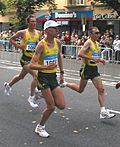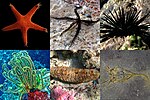point that arm swing improves the stability and energy efficiency in human locomotion. Those positive effects of arm swing have been utilized in sports,...
13 KB (1,702 words) - 01:49, 14 November 2023
Gunslinger's gait (category Human behavior)
other Russian officials that exhibited a similar style of walk. Arm swing in human locomotion "How KGB Training Shaped Putin's Highly Unusual Walk". HuffPost...
3 KB (342 words) - 16:35, 21 September 2024
arboreal in habitat, for example, the tree snail. Brachiation (from brachium, Latin for "arm") is a form of arboreal locomotion in which primates swing from...
78 KB (8,879 words) - 20:25, 8 December 2024
Brachiation (redirect from Arm swinging)
Brachiation (from "brachium", Latin for "arm"), or arm swinging, is a form of arboreal locomotion in which primates swing from tree limb to tree limb using only...
12 KB (1,419 words) - 15:42, 7 September 2024
during rhythmic arm locomotion between the upper and lower limbs. The amplification of the contralateral tibialis anterior seen during the swing to stance transition...
18 KB (2,293 words) - 05:52, 18 November 2022
during locomotion. Human gaits are the various ways in which humans can move, either naturally or as a result of specialized training. Human gait is...
36 KB (4,877 words) - 19:08, 24 October 2024
Bipedalism (redirect from Evolution of bipedalism in humans)
terrestrial locomotion where an animal moves by means of its two rear (or lower) limbs or legs. An animal or machine that usually moves in a bipedal manner...
80 KB (9,571 words) - 00:11, 9 January 2025
Walking (category Wikipedia articles in need of updating from July 2018)
insects when traversing uneven terrain. Sport of athletics portal Arm swing in human locomotion Duckwalk Footpath Gait training Hand walking Hot Girl Walk International...
57 KB (7,210 words) - 07:51, 22 December 2024
through vestibular caloric stimulation. Hemispatial neglect Arm swing in human locomotion Brain damage Neuropsychology Sampanis, D.S. e Riddoch, J. (2013)...
4 KB (504 words) - 06:02, 30 May 2023
forms of locomotion may be more appropriate for a number of reasons, for example traversing rough terrain, as well as moving and interacting in human environments...
27 KB (3,576 words) - 14:09, 16 June 2024
movement is a method of human locomotion that makes use of all four limbs. It is one of the earliest gaits learned by human infants, and has similar...
9 KB (1,075 words) - 15:34, 19 November 2024
Spinal locomotion results from intricate dynamic interactions between a central program in lower thoracolumbar spine and proprioceptive feedback from...
18 KB (2,411 words) - 16:49, 7 August 2023
Pelvis (redirect from Human pelvis)
to walk. In contrast, human male pelvises are not constrained by the need to give birth and therefore are more optimized for bipedal locomotion. The principal...
48 KB (5,937 words) - 19:17, 31 December 2024
Limitations of animal running speed (category Terrestrial locomotion)
Carrier, D., Heglund, N. & Earls, K. 1994 Variable gearing during locomotion in the human musculoskeletal system. Science 265, 651–653. Hildebrand, M. 1994...
9 KB (1,181 words) - 17:14, 12 July 2024
Running (category Terrestrial locomotion)
method of terrestrial locomotion by which humans and other animals move rapidly on foot. Running is a gait with an aerial phase in which all feet are above...
64 KB (7,401 words) - 19:09, 20 December 2024
Interlimb coordination (category Animal locomotion)
rhythmic activity related to arm swing, even when the arm is paralyzed. The EMG activity shows that coordination of arm-leg movement still provide stimulation...
18 KB (2,157 words) - 01:47, 30 November 2023
75: 58–61, 1975. Neural control of locomotion - a kinetic analysis of the trot in cats. Neural Control of Locomotion. pp. 759–762. Plenum Publishing Corp...
31 KB (3,565 words) - 05:48, 5 December 2024
Developmental psychology (redirect from Human development (psychology))
way to explain discrete phenomena of human development such as affect, second language acquisition, and locomotion. One critical aspect of developmental...
137 KB (16,739 words) - 17:55, 5 January 2025
Automation describes a wide range of technologies that reduce human intervention in processes, mainly by predetermining decision criteria, subprocess...
97 KB (11,460 words) - 16:18, 31 December 2024
Echinoderm (redirect from Sexual reproduction in echinoderms)
The arm regeneration potential of brittle stars is being studied in connection with understanding and treating neurodegenerative diseases in humans. Genomic...
112 KB (11,290 words) - 01:19, 8 January 2025
GuRoo (category All Wikipedia articles written in Australian English)
torque/low speed combination to suit the anthropomorphic nature of human locomotion. In addition, no joint is required to move through more than one complete...
6 KB (847 words) - 11:57, 21 November 2024
Acrocanthosaurus (category All Wikipedia articles written in American English)
Acrocanthosaurus was limited in its range of motion compared to that of humans. The arm could not swing in a complete circle, but could retract (swing backward) 109°...
50 KB (5,202 words) - 22:11, 6 January 2025
Human physiology of underwater diving is the physiological influences of the underwater environment on the human diver, and adaptations to operating underwater...
105 KB (12,107 words) - 06:32, 9 December 2024
Gait deviations (category Terrestrial locomotion)
nominally referred to as any variation of standard human gait, typically manifesting as a coping mechanism in response to an anatomical impairment. Lower-limb...
42 KB (4,954 words) - 01:26, 25 May 2024
Australopithecus sediba (category Mammals described in 2010)
Harvati, K. (2016). "Adaptation to suspensory locomotion in Australopithecus sediba". Journal of Human Evolution. 104: 1–12. doi:10.1016/j.jhevol.2016...
54 KB (6,792 words) - 15:13, 8 January 2025
Milne-Edwards's sifaka (category Mammals described in 1871)
2011. Crompton, R. H.; W. I. Sellers (2007). "Locomotion and predator avoidance in prosimian primates". In K. A. I. Nekaris; S. L. Gursky (eds.). Primate...
15 KB (1,639 words) - 12:53, 1 June 2024
Locomotor effects of shoes are the way in which the physical characteristics or components of shoes influence the locomotion neuromechanics of a person. Depending...
22 KB (2,842 words) - 17:39, 28 October 2024
Functional electrical stimulation (redirect from Functional electrical stimulation in spinal cord injured patients)
deliver simultaneous reaching and grasping, or bipedal locomotion. Note: This paragraph was developed in part using material from the following reference....
51 KB (6,633 words) - 18:21, 12 November 2024
Massospondylus (category Fossil taxa described in 1854)
locomotion. Since the discovery of rudimentary and nonfunctional clavicles in ceratopsians, it was assumed that these shoulder bones were reduced in all...
81 KB (8,327 words) - 23:13, 8 January 2025
Paranthropus robustus (category Fossil taxa described in 1938)
M. H. (1974). "Reviewed Work: Early Hominid Posture and Locomotion by John T. Robinson". Human Biology. 46 (4): 719–724. JSTOR 41462378. Clarke, R. J.;...
107 KB (13,512 words) - 15:12, 8 January 2025
























